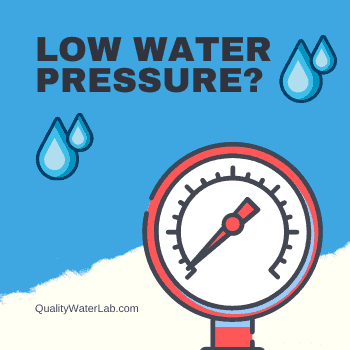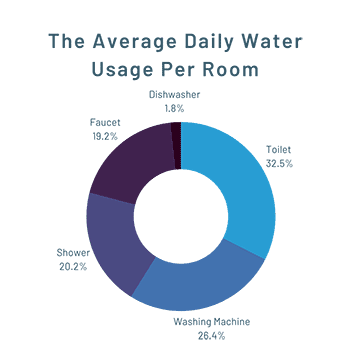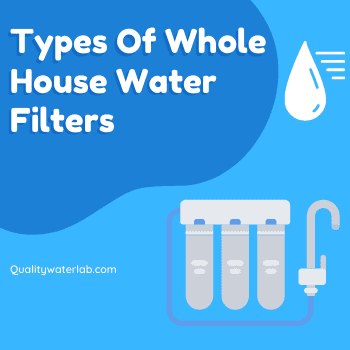
If your tap water isn’t as good as it should be, installing a whole house filtration system is an affordable, straightforward solution. But like most people, you’ve probably heard horror stories from friends about filters reducing their showers to a trickle.
Are whole-house water filters worth the risk? Will your water pressure fall off a cliff?
The truth is — water filtration systems are often blamed for reducing water pressure, but it’s a bad rap. Let’s explore how you can minimize the risk and enjoy better-tasting, healthier water.
Does a Whole-House Water Filter Restrict Water Flow?
All water filters restrict flow to a certain extent. But whether there’s a noticeable drop in water pressure depends on a wide range of factors, many of which can be optimized to improve the performance of a whole-home filtration system.
We’ll review them all, but first, let’s clear up the jargon.
Understanding The Basics of Flow Rates & Water Pressure
The terms flow rate and water pressure are often used interchangeably. Practically speaking, they’re similar, but the terms mean something a little different when you’re looking at technical specifications.
Flow rate is the maximum number of gallons per minute that move through a water filter. Water pressure is the speed and intensity at which it flows. They’re the top two factors, among many, that determine how well whole-house systems work.
Factors Influencing Water Pressure and Flow
Before having a whole-house water filtration system installed, understanding how it affects your home’s water pressure will help you make a sound purchase. Some factors are within your control while others aren’t.
Home Water Pressure
The pressure at which water flows into your home impacts filter efficiency. The rate depends on factors from climate conditions to how far your water has to travel from the source.
The further away your water supply is from your home, the lower the pressure is. And if there’s a drought, you may notice a drop. If you get water from a major river, lack of rain won’t make a noticeable difference in pressure, but you can expect a much greater effect on shallow wells.
All water filters have incoming pressure requirements. If yours is too low, it will impair system performance.
Water Demand

Household water usage, from flushing the toilet to running the dishwasher, use 1.5 -3 gallons of water per minute each. The more water-using activities you do simultaneously, the greater the demand it puts on your water filter. If the total usage exceeds the filter’s maximum rate of flow, pressure at each tap will drop. Avoid filtration systems that can’t keep pace.
If you use municipal water, your water meter tracks total consumption, but it doesn’t tell you your peak use. If you have a well, you don’t have the benefit of a water meter, but you can use these averages to understand how much water your family needs at any given time:
- Bathroom faucets: 1 gpm
- Kitchen taps: 1.5 gpm
- Shower heads: Up to 2.5 gpm
- Toilets: 2.5-4.0 gpm
- Washing machines: 25.0 gallons per load
- Dishwashers: 6.0 to 20.0 gallons per load
Water Quality
If you pour water through a coffee filter, it slides right through. But add mud, and the water flow slows to a drip. The harder a filter has to work, the more likely it will reduce pressure.
Limescale
Homes with hard water and no water softeners may have limescale buildup in the plumbing. A thick, sticky residue made primarily of calcium, decreases the overall diameter of your pipes and restricts water flow.
Plumbing Size
Most homes have 3/4- to 1-inch pipes, and most filters are compatible. You can use an adapter to make a filter designed for 1-inch pipes fit 3/4- inch plumbing. But a mismatch may cause water to flow at a slightly slower rate.
Home Height
Water pressure decreases by a half-pound per square inch for each foot pipes rise above your home’s water supply. Second- and third-story bathrooms may already have lower-than-average pressure which might be further affected by adding a whole-house water filter.
Filter Type
All filter media restricts the flow of water to a degree. The density helps the filter trap unwanted contaminants. But some types are more restrictive than others. We’ll review those below.
Filter Flow Rates
Filter flow rates are reported as maximums. A filter system with an 8–12-gallon per minute flow rate may produce less depending on the above factors. But you can maximize water flow and pressure by choosing a whole-house system with the highest possible rate.
Types of Whole House Water Filters

The type of whole-house water filter you choose can drastically affect water pressure:
Sediment Filters
Sediment filters remove large particles of dirt, rust and silt. They’re included in most multi-stage whole-house filter systems to protect the more delicate filters. If your water is heavily contaminated, expect them to clog quickly. Maintenance is essential.
Carbon Filters
Activated carbon filters use either granular or solid blocks of carbon to remove contaminants. Block carbon filters are the most effective but process water at a slightly slower rate.
Reverse Osmosis (RO)Filters
A reverse osmosis system removes greater than 99-percent of incoming contaminants in drinking water. That kind of thorough filtration takes time, however, and it can drop your water pressure like a lead balloon if your water is thick with contaminants.
Water Softeners
Salt-based softeners use an ion exchange process to remove hard minerals from water. Salt-free softeners, or water conditioners, use Template Assisted Crystallization (TAC) technology to prevent limescale without removing minerals. Neither process significantly affects water pressure.
Tips for Improving Your Water Pressure from a Whole-House Water Filtration System
Choose the Right Type of Whole-House Water Filter System:
The right filter can make or break your pressure. Carbon filters, for example, remove most contaminants that make water taste bad with a negligible impact on water pressure. Reverse osmosis specializes in purifying water at a single tap, but it has a greater effect.
Uncommon in a whole-home water filter system for that reason, most RO filters are made to fit under kitchen sinks where they treat water specifically for drinking and cooking purposes.
Some homeowners with very dirty water combine a whole-house filter system for home-wide benefits with an RO unit at the kitchen sink to improve contaminant removal in their drinking water.
Check Your Pressure Tank
If you have a well, water is stored in a pressure tank until you’re ready to use it. If the settings on the pressure switch are wrong, the system may not perform optimally.
Also, make sure the shutoff valves controlling water flow into your home are fully open. No whole-house water filtration system is efficient without enough incoming pressure.
Maintain Your Water Filter System
The average sediment cartridge lasts only three to six months. Carbon filters last six to twelve months depending on the size and type. Expect a reverse osmosis membrane to have clogged pores within three to ten years.
Nothing reduces water pressure like a clogged filter cartridge. But a properly maintained filter shouldn’t greatly affect water pressure.
Treat Limescale
If you have hard water, installing a whole house water softener will prevent clogged pipes due to limescale. Choose from conventional softeners or salt-free water conditioners to stop build-up in its tracks — they can even remove existing limescale.
As an added benefit, both will extend the life of your hot water heater — it can cost $1000 to have your tank replaced —and household appliances. They’re a good value.
Check Your Faucets
Clogged faucet aerators can reduce your water pressure. As water passes through them, it deposits debris in the screens. Check the kitchen tap and other faucets for buildup.
Change Your Use Patterns
Changing your water use patterns can reduce peak demand. Having several open taps flowing simultaneously will reduce water pressure with or without a whole-house water filter.
Instead, stagger showers, run the dishwasher and washing machine off-hours, and backwash softeners overnight. A small change in habits and a good filtration system will improve water throughout the whole house.
Final Thoughts
If you’re worried that a whole house water filter will cause an annoying drop in water pressure, consider the health consequences of drinking tap water with contaminants. Filtered water is healthier and tastes better.
It’s that simple.
So, while we can’t promise that a whole house water filter won’t reduce your pressure at all, we know from experience that choosing the right filter and maintaining it properly minimizes pressure loss while improving your water quality. You owe it to yourself and your family.
 121 people found this helpful. Was this guide helpful to you?
121 people found this helpful. Was this guide helpful to you? 

